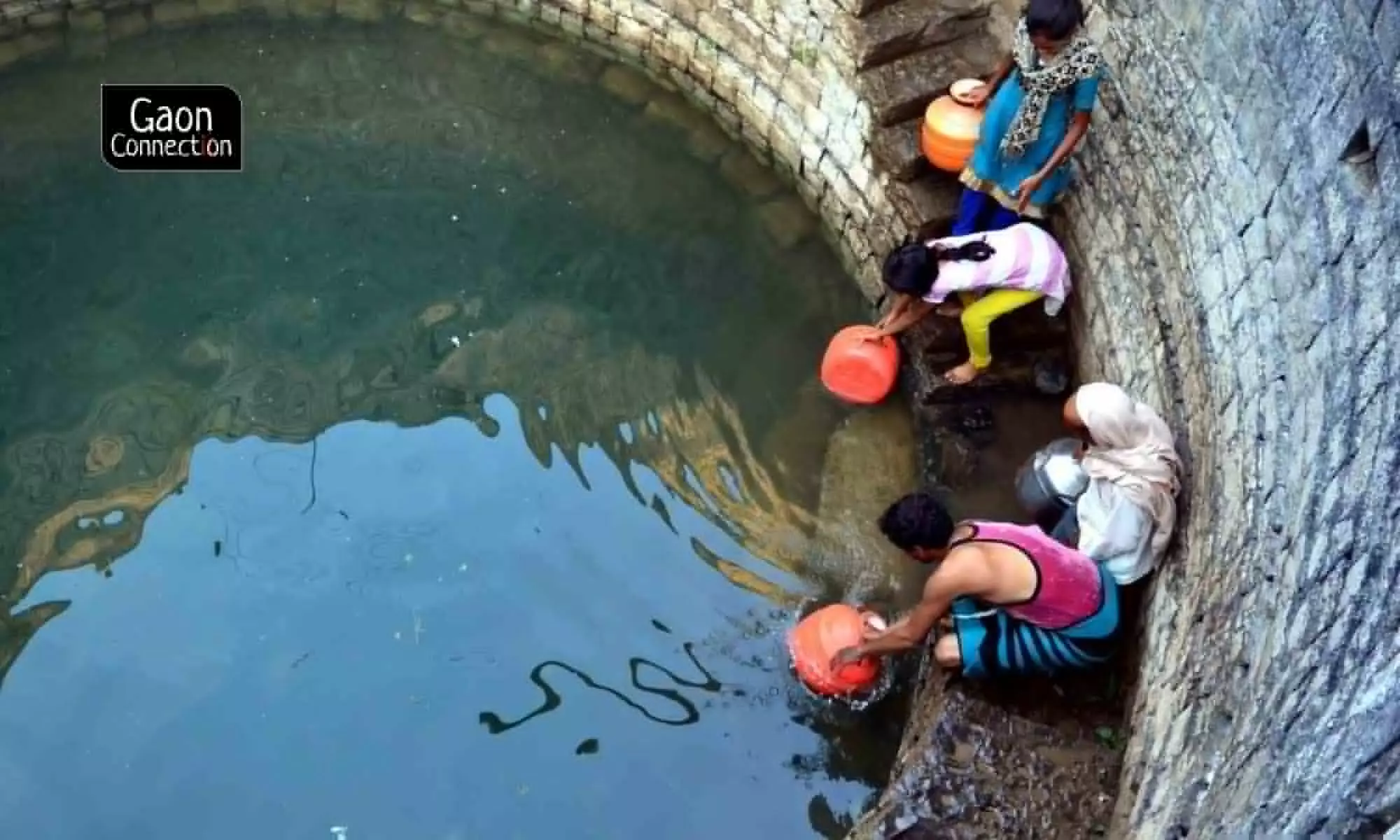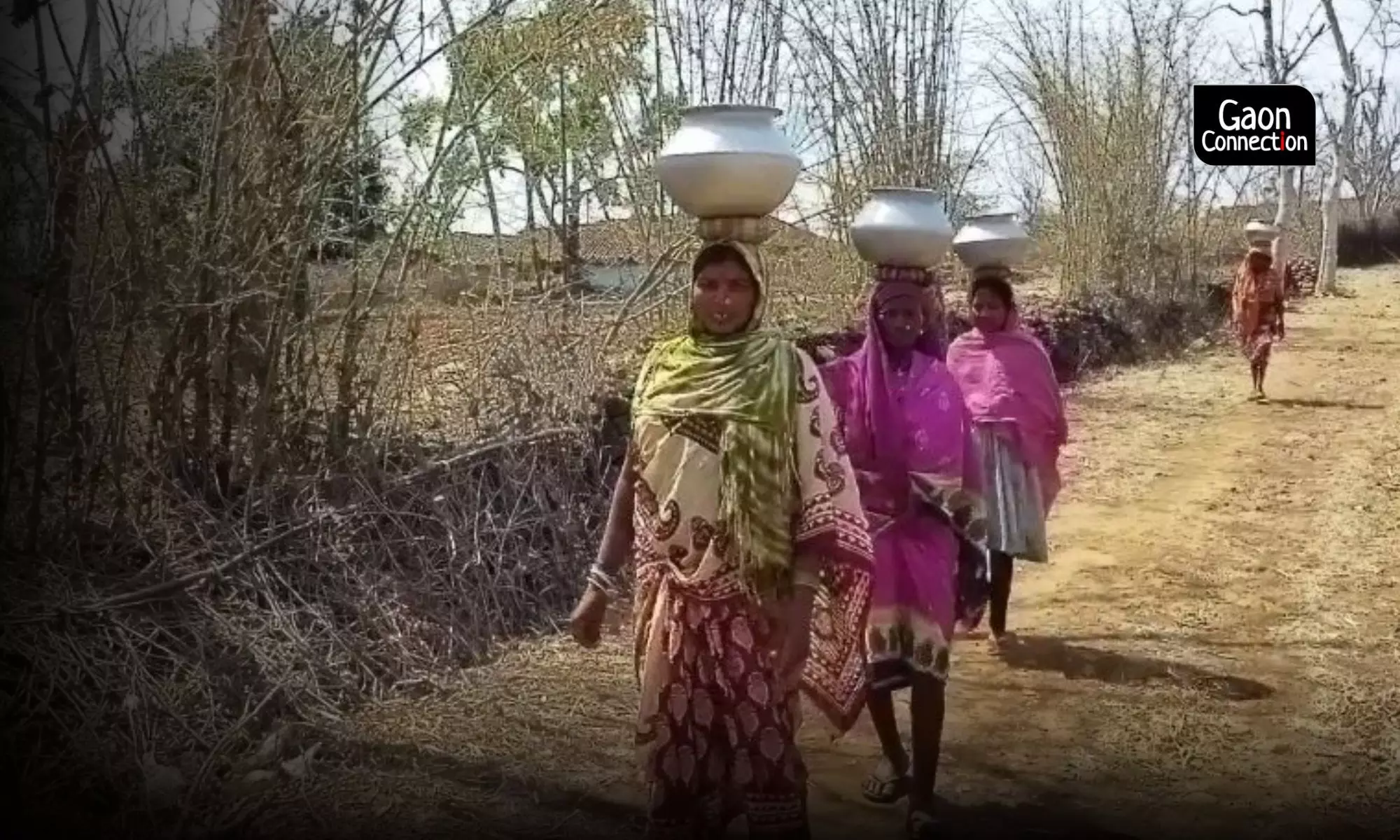Chitrakoot, Uttar Pradesh
For Sukhai and his wife Rajmati, life has become a living nightmare as they face the very real possibility of leaving their home and becoming refugees. The farmer couple, who reside in Uchchadi village in Chitrakoot district of Uttar Pradesh, face acute water shortage as the water sources in their village have dried up.
“The situation is very bad here. We used to have enough water to irrigate our crops, but now the water level has gone down so much that we can barely get enough water for our daily needs,” 30-year-old Sukhai said. “We have to walk miles every day to fetch water from a nearby well, and it’s a huge struggle,” he added.
His 24-year-old wife Rajmati said that the situation is so bad that people can’t afford to bathe or even wash their clothes for weeks together. “It has also affected our health. We can’t wash our clothes properly, and the lack of clean water has led to skin infections and other diseases,” she told Gaon Connection.
Fed up with the growing conflict, Sukhai and Rajmati are planning to leave the village and migrate to a city where they can find work as menial labourers at construction sites. They are not alone as many villagers, defeated by the water crisis, are migrating.
Displaced by climate change
According to a report by the Internal Displacement Monitoring Centre (IDMC), India accounted for the highest number of new internal displacements in the world in 2020, with over 9 million people forced to flee their homes due to climate-related disasters such as floods, cyclones, and droughts.
The slow violence of climate change is forcing people to leave their homes and seek refuge elsewhere. The IDMC report notes that most of the displacements in India were caused by droughts, which are becoming more frequent and severe due to climate change.

As water becomes scarce, conflicts over resources are likely to escalate, leading to social unrest and displacement. Photo by Nidhi Jamwal
“The situation is very worrying, as the displacement of people due to climate change is likely to increase in the coming years,” Harjeet Singh, global lead on climate change at ActionAid International, told Gaon Connection. “We need urgent action to address the root causes of climate change and support the affected communities,” he said.
In Chitrakoot, which is a part of the drought-prone Bundelkhand region of central India, the situation is so bad that for weeks people have not taken a shower. “Water is such a scarce element in this region that people consider bathing as wasting water. With the temperature hovering over 42 degrees Celsius, people don’t bathe for days,” Raja Bhaiya, Convener of the non-profit, Vidya Dham Samiti, in Chitrakoot, told Gaon Connection.
Also Read: They live along the river bank, but have no water to drink – the story of dry Betwa
Rising conflicts
There is just a lone tubewell in Uchchadi village that is the source of water. And even that is getting scarce. Women begin lining up from four in the morning with their pots and pans to collect water and it is not uncommon for arguments and even physical altercations to break out.
“This violence is just an expression of the desperation caused by the water crisis. There is an urgent need to ensure equitable access to water for all,” Raja Bhaiya said.
The Indian government has launched various initiatives to address the issue of water scarcity, including the Jal Shakti Abhiyan, a national campaign to conserve water, and the Pradhan Mantri Krishi Sinchai Yojana, which aims to increase the efficiency of irrigation systems. However, these efforts are yet to yield significant results.

The slow violence of climate change is forcing people to leave their homes and seek refuge elsewhere.
Experts have long warned of the effects of climate change, but the issue has been largely ignored by policymakers.
“The government’s initiatives are a step in the right direction, but much more needs to be done to address the scale of the problem,” said Harjeet Singh. “We need to ensure that the affected communities are at the centre of decision-making and are given the resources and support they need to adapt to the changing climate.”
“The government needs to do something. We need water to survive, and we need help,” Sukhai said.
Har Ghar Jal
“The government has launched several initiatives to address the water crisis in Chitrakoot, including the construction of check dams and the installation of hand pumps. We are working in this direction,” Swatantra Dev Singh, water resources minister in Uttar Pradesh, said. He added that schemes like Har Ghar Jal (piped water in every house) have been launched and Chitrakoot is a focus area.
As per Har Ghar Jal data, 61.81 per cent of rural households in the country have been provided functional household tap connection, as of May 18, 2023.
In Uttar Pradesh slightly more than 43 per cent rural households have tap connections. In Chitrakoot district, the coverage is 77.38 per cent, as per the official record. The district has 563 villages, of which 101 villages have got 100 per cent tap water connections; water supply works are in progress in 415 villages; and the works are yet to begin in 47 villages.
The impact of climate change is not limited to just the environment; it also has severe social and economic consequences, point out climate change experts. As water becomes scarce, conflicts over resources are likely to escalate, leading to social unrest and displacement.

India accounted for the highest number of new internal displacements in the world in 2020, with over 9 million people forced to flee their homes due to climate-related disasters.
Also Read: Rising heat, sinking groundwater and violent conflicts over irrigation in UP. A ground report
“Climate change is a slow violence that is affecting the most vulnerable people in our society,” said Sunita Narain, director-general of the Centre for Science and Environment. “It is a humanitarian crisis in the making, and we need urgent action to mitigate its impact.”
Governments and policymakers need to prioritise climate adaptation and mitigation measures to prevent further damage to the environment and its people. This includes investing in renewable energy, water conservation, and sustainable agriculture practices.
“We need to take action at the local and national levels to address the challenges posed by climate change,” said Narain. “We need to ensure that the most vulnerable communities have access to clean water, food, and shelter and that they are empowered to take part in the decision-making processes that affect their lives.”
For Sukhai and Rajmati, the future remains uncertain. They are worried about their children’s future and the survival of their community. “We want our children to have a better life than us. We want them to have water and food and a future,” Sukhai said.
The couple’s story is a reminder of the human cost of the climate crisis and its deep impact on the lives of marginalised communities. “We are not asking for much, just some water to drink and to grow our crops. We don’t want to leave our home, but if things don’t improve, we might have to,” said Rajmati.


















